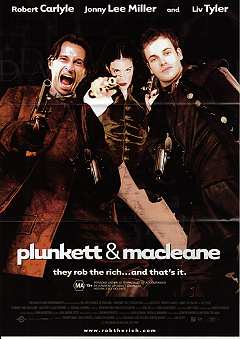click for new |
 |
Festivale online magazine
|
| Plunkett & Macleane
Based-on-a-true-story, Plunkett and Macleane are a couple of Highwaymen who lived in eighteenth century London. The story makes a beautiful period drama with a twist: it's also a modern style action film with the requisite love interest. We start in 1748, and Macleane the fallen aristocrat (Jonny Lee Miller) is drunk and in debtor's prison. Suddenly destiny arrives in the form of a stray carriage wheel which violently bursts down his door. In the ensuing confusion, he witnesses a botched hold up and the death of one of the Highwaymen, who has been shot in the scuffle. In his dying moments he swallows his booty, a large red ruby.
|
 Movie Poster, Plunkett and Macleane |
|
After his escape, Macleane follows the body to the graveyard, where he digs it up. Waiting for him is Plunkett (Robert Carlyle) who wants his dead partner's prize but doesn't have to get his hands dirty now that Macleane is here and proves rather co-operative with a gun pointed at his head.
After retrieving the gory piece (necessitating a second swallowing of the blood soaked jewel), the two are arrested and find their way to jail, where class conscious London dictates different treatment awaits. Macleane's life here is more pleasant than Plunkett's but he agrees to combine their skills to get both of them out, using the ruby as bribe. On the outside the two agree to continue the partnership as Highwaymen so that Macleane can afford his opulent lifestyle and Plunkett can fund his trip to the New World. They use Plunkett's spoils to set up as Master and Servant living the high life in fashionable society; Macleane gleaning information which the two use to their advantage by robbing their unsuspecting acquaintances on the way home. They hit the jackpot on their first robbery when they stop the Lord Chief Justice and his beautiful but rebellious niece, Lady Rebecca Gibson (Liv Tyler). The first instigates a major man-hunt (and the beginnings of the Police Force) while the second, well, love starts to bloom between the two pretty young things. The two leads do quite well in their roles, Jonny Lee Miller in particular taking obvious pleasure sending himself up. Robert Carlyle is getting very proficient at doing grotty working class and Liv Tyler is just gorgeous. She makes a rather sad looking beauty, which is exactly as it should be for her role. You never do get to see her in the tight pants she wears on the poster but her Georgian frocks are most becoming, although a little too out of period for my liking. Licence has also been taken with her hair and makeup: when you have a lead as striking as Tyler you don't need to go to extremes to make sure she stands out. Most of the entertainment value comes from Alan Cumming playing a very camp (and very modern) Lord Rochester, friend to Macleane. He gets to wear the best costumes and has lots of fun with some wickedly risque dialogue. He proves a worthy foil to Macleane, and flirts playfully with his "rough trade" Plunkett. The film features a mainly modern soundtrack, designed no doubt to appeal to the younger set, but I found the combination of meticulous elegant period detail with synthesizers rather unsettling. On the whole it's an entertaining and enjoyable film and the climax in particular is done well, but don't look too closely at the plot for holes you will see. For example, did Plunkett really need Macleane's help in bribing their way out of jail? After all, he did have a large ruby at his disposal. And if Plunkett had all that money stashed away, surely he already had enough to leave old Blighty? It costs plenty to set up and support a gentleman, especially when he's a lousy gambler like Macleane. And what exactly was Macleane going to do once he'd dug up that body if he wasn't going to plunge his hands into the gizzards to retrieve the ruby? Even bigger questions arrive with the Lady Rebecca, but I'll leave those for you to enjoy. |
| Nicky Jenkins
Due for Australian release May 20, 1999 | |
 |
|
|

 Published in Melbourne, Victoria, Australia
Published in Melbourne, Victoria, Australia